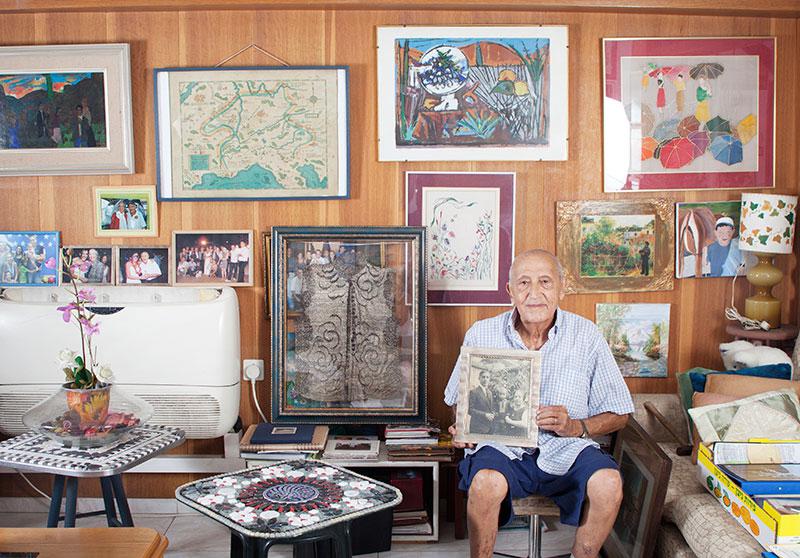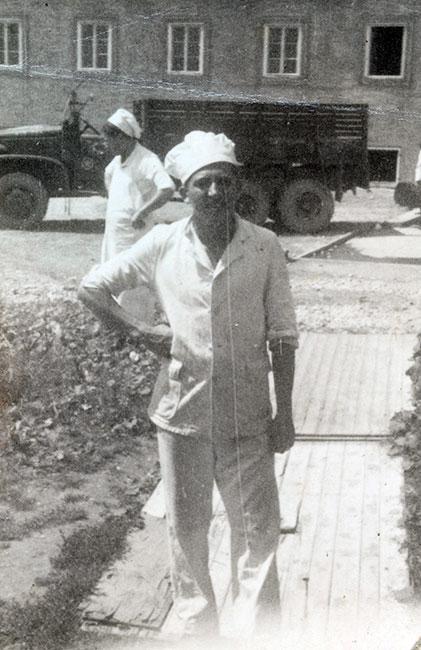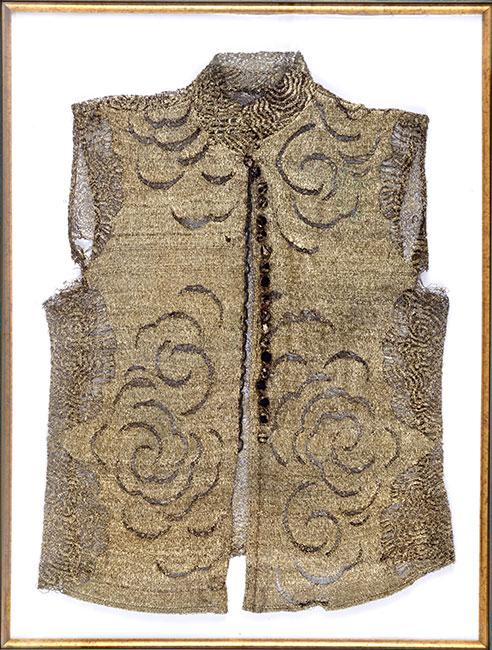From Left to Right: Norit Prachi, daughter of Marcel Levi; Marcel Levi and wife, Rachel Levi, Avi Dichter, Chairman of the Foreign Affairs and Defense Committee; Avner Shalev, Chairman of Yad Vashem; Vivian Uria, Director of Yad Vashem's Museum Division
Courtesy of Yad Vashem
Marcel Levi holding a picture of his family that was murdered in the Holocaust together with his wife, Rachel and daughter Norit.
Courtesy of Yad Vashem






Yad Vashem's vast and unique collections of artifacts from the period of the Holocaust consist of various personal items from Holocaust victims and survivors. These items are essential tools that help convey the narrative of the Holocaust from a personal perspective and disclose the stories of individual people, families, and at times, entire communities.
A rotating monthly exhibition highlighting one of these personal artifacts will now be housed in the Yad Vashem Visitor's Center. The first item that was chosen is an exceptional hand-embroidered waistcoat that once belonged to Marcel Levi.
Marcel Levi was born in Thessalonica, Greece in 1925 to Yosef and Sol Levi. The couple had two children, Marcel and his younger brother, Edmond, born in 1933. In April 1943, the Levi family was forced to move from their home into the Baron Hirsch quarter of the city together with the rest of the local Jewish population until they were deported to Auschwitz. Upon their arrival in Auschwitz after a long and tortuous journey, the family was separated. Sol and 10-year-old Edmond soon vanished; a short while later, 17-year-old Marcel was separated from his father and sent to work. “They hurried us to a different building, where we were given a ‘new name’: a number tattooed on our arm. My new ‘name’ was ‘116491’,” Marcel recalled in his testimony. “We were in shock, we were unable to grasp what was happening to us. All our thoughts and fears were focused on our parents and the small children. Where were they? Were they safe? Only after a few days did we begin to understand that when we had been severed from our parents, they had gone on their final journey, to the crematoria”.
Shortly before their deportation to Auschwitz, Sol deposited a silver hand-embroidered waistcoat she made for Marcel, along with other cherished possessions, with their non-Jewish neighbors for safekeeping. Tragically, the entire Levi family was murdered at Auschwitz, expect for Marcel who was sent to a forced labor camp. Marcel spent two years in forced labor. Those prisoners who could not work at the required pace were immediately sent to their deaths in the gas chambers.
In early 1945, the prisoners of the camp, including Marcel, were led on a death march from the labor camp to an area close to the Dachau concentration camp in Germany. Marcel was determined to survive and held on to the remnants of his strength as he marched through the freezing snow. His fellow prisoners who were unable to continue walking were shot to death. The prisoners were finally liberated by the 42nd Infantry "Rainbow" Division of the American Army. “We were sure that all of us were about to be killed at any moment, that everything would end here. And then, they suddenly left; a strange quiet descended upon us. The Germans disappeared before our very eyes; someone suddenly stood up and shouted: ‘They’ve run away! They’ve run away!” Within a very few minutes people began to get up; it was difficult to believe that we had been left alone, with no Germans. We turned around and approached the gate; people started to run every which way in a state of tremendous excitement. Tears of joy were mixed with tears of relief but also grief over everything we had been through. After a short while the camp started filling with soldier's ̶ American soldiers!”
Sidney Shafner, a Jewish American among the soldiers who liberated Marcel, saw that he was very ill and took him under his wing. For the next three years Marcel was connected with this army division. With his renewed strength, Marcel began assisting in the kitchen. At the completion of their tour, the entire unit received a special souvenir, a map with illustrations that humorously described the unit’s advance in Europe and the battles they had fought.
Marcel was the sole member of his family to survive the Holocaust. The hand-knitted waistcoat was one of the only possessions retrieved from the treasured belongings left by his late mother Sol, with neighbors at the beginning of the war. In 1948, Marcel immigrated to the Land of Israel, where he fought in the War of Independence. In memory of his family members who were murdered in the Holocaust, he donated the waistcoat to Yad Vashem for safekeeping in July 2013.
Today, Marcel returned to Yad Vashem for a special ceremony to unveil his newly displayed waistcoat. He was joined by the Chairman of Yad Vashem, Avner Shalev, the Chairman of the Foreign Affairs and Defense Committee, Mr. Avi Dichter and the Director of the Museums Division at Yad Vashem, Vivian Uria as well as Holocaust survivors and friends. At the ceremony, Marcel remarked:
"Today I come full circle. This item is the only item I have left of my family. From now and for all time, it will be kept here at Yad Vashem and will serve as a testimony for future generations."



